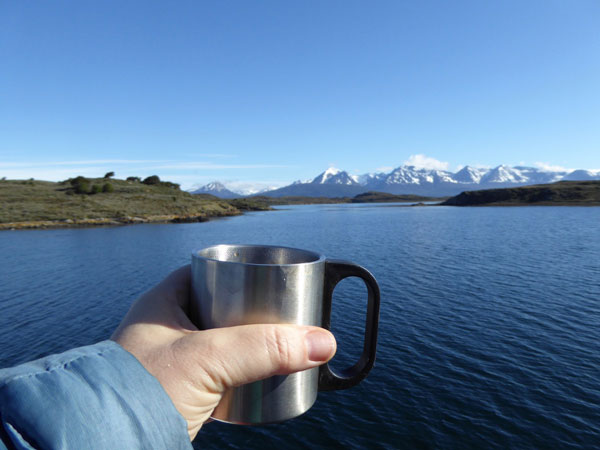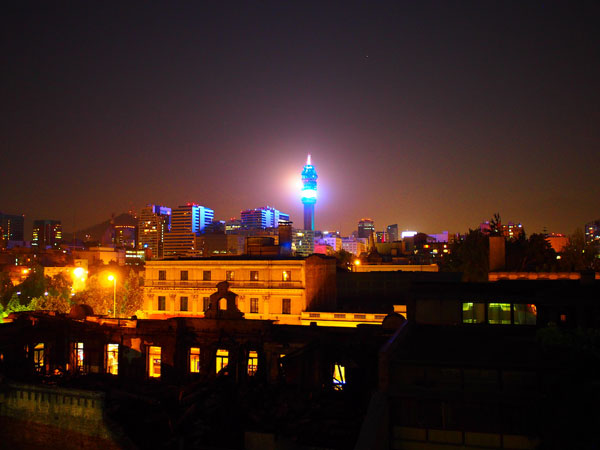Illustration: Manuela Montero, used with permission.
It is impossible not to notice many differences between there and here. In my case, there is the United States, and here is Chile. More specifically, I’m going to compare San Francisco and Santiago, and our take on food products.
In the United States, there have been many books published on food politics. I particularly recommend Michael Pollan’s The Omnivore’s Dilemma (which did not turn me into an omnivore), and Barbara Kingsolver’s Animal, Vegetable, Mineral (which did not make me move to Virginia).
Some of the basic tenets have to do with a bit of back-to-the-land coupled with no cruelty, do-it-yourself, and always, locavore eating. Eat locally. Don’t buy imported berries out of season (from Chile!), wait until they’re local and eat them excessively, until your teeth turn blue.
What’s funny about this, is that as the United States learns these lessons, here in Santiago, it’s just how we live. A trip to the Vega on Tuesday yielded winter fruits and vegetables. It’s not my favorite time of year for food, except for the cruciferous vegetables. I miss the aforementioned berries an awful lot, and also tomatoes so juicy you need a moat around your cutting board to cut them.
The other main difference between San Francisco and Chile in terms of food products, is a bit of a nomenclature disconnect. As food practices grow (or return to being) ever more precise in San Francisco, you have very adjective-heavy food products. Salt, for example, is no longer salt. It is Himalayan (extra points for pronouncing it hi MAL e yn) pink salt, and smoked salt, and salt flakes. NaCl has moved beyond “it pours when it rains” Morton’s iodized table salt, and has become a terroir-produced products. You have salts of origin, cachai?
But it’s not just salt in San Francisco. It’s tomatoes. They’re heirloom, from the Central Valley, harvested early or late, ripened on the vine, grown on ancestral lands, picked by well-paid workers who get health insurance (this part I do think is important, prices be darned).
See what I mean? In Chile, we have tomatoes. They often come from Limache. Sometimes La Serena. These do not follow the 100-mile rule, but they are from here, trucked down I-5 (The same I-5 that runs through California). They are also light on adjectives. Sure, you might get something organic, or oranges that say “Fanta” on the sign above them, a joke about how sweet they are. But you’d never find elaborately-named adjectives-strung-together-like-hand-popped-popcorn-on-a-string food. It’s just food. And I’m sure whatever they’re producing in California is haughtier and harder-to-find and lovingly tended by fairies. But here we just have great produce. And the food naming tradition in California (and other places in the US?) is also tremendously fun to poke fun of (see illustration)
Finally writing this post which has been kicking around in my head for quite some time was inspired in part by David Sedaris, who jokes, in a piece called Today’s Special in his book Me Talk Pretty One Day “I’d order a skirt steak with a medley of suffocated peaches, but I’m put off by the aspirin sauce.” So consider that another book recommendation from me to you.
Practical detail, featured Illustration: how it happened.
Manuela and I are friends on twitter. She tweeted that she enjoyed the blog, and I tweeted that I liked her work. She then generously offered an illustration for the blog. We exchanged a few emails, and she nailed it on the first try. If you are an illustrator and would like to be featured here, feel free to drop me a line at bearshapedsphere@hotmail.com. I’m excited to share my meager platform with other artists. I am extremely pleased with how this worked out, and I hope you like it, too! Drop by and give Manuela some love.











Love Manuela’s drawing. The “Picked by elves” made me laugh.
We are so lucky with the fruit and veggies we have in Chile, especially the price and I think I’ve been out of touch with all of the adjective-laden food labels in other countries.
Here the sign just says… Tomatoes.
If you ask what type, they’ll say “De lo bueno”.
De lo bueno, Rob, notable! I do care where stuff comes from, to some extent, but we don’t really get that insanely large a variety of items, so maybe that’s why we don’t have such detailed signs. I wrote the text, but let her choose among several different items, depending on what she wanted to draw. There were also some toadstools danced upon by fairies, but I love how the tomatoes turned out.
lovely illustration! also, tangentially related:
http://www.huffingtonpost.com/2012/05/24/fake-menu-for-fuds-parodies-foodies_n_1543086.html?ref=food&ir=Food#s=1017569
thanks for the link, Peter. The food thing makes me insane when I’m in the United States. And yet at the supermarket, you can’t even get real bread. Curious that.
Nice post–love the illustration! kudos to both you and Manuela.
Here in Chile I occasionally ask where something is from (for example, when it seems a bit out of season) and they’ll say: del campo (from the country).
For most people here, food is just food and it’s either good or not…
I know! I asked someone at the vega recently where some almonds were from and he said “aquí.” And I was like, here in the vega? Well, it turned out they were from Stgo trees, so he was mostly right, but still, the whole “origin” thing seems only to work for wine and olives so far. Sometimes cheese.
The illustration turned out lovely!
I know! so psyched about it! plus I’ve been meaning to write that post for forever, and didn’t have an image to go with it, so it was perfect!
Thank you so much Eileen! And thanks everyone for the comments, I’m very happy you like the illustration, I really enjoyed this collaboration.
tai loca? (Are you nuts?) It was a pleasure, Manuela. I already told you this, but it turned out pretty much exactly how I wanted, or even better. You aced it!
Great illustration! Having recently gotten all breathy over the goods in the Ferry Building, many of which I’m pretty sure were supposedly picked by elves, I had to laugh at this.
I like that here, things just sort of come from the campo, and that’s where they’re from, and it’s obvious, but I wonder how long it’ll last (or if, in fact, it’s still always the case). So much of the food offerings in Chile seem to be headed toward industrialization and importation that I wonder if I’m being naive to think produce here is still simply good produce.
you know, Emily, I was exactly thinking of the market outside the Ferry building when I wrote this piece. I don’t know how “exquisito” Chile will get about the food. Hopefully we skip right over that and slide into organics without missing a beat. And by the way, on an impulse I bought lúcuma the other day. And I don’t know where they came from. I ask, but they just stay silent. Sad.
Uh-oh! You mean I’ve been mispronouncing Him-a-LAY-yen all these years? Agreed, here we eat the way we used to eat about a million years ago, back when I was growing up in Texas.
Love Manuela’s pretty addition to the word magic.
I love the fresh fresh of produce here but do worry about the extensive use of GM, sprays [often still visible on the fruit! ew] and conventional farming practices here. Then I am heartened that I need to go to the organic markets early as they usually run out due to the growing demand for their produce.
Hope to see more locally grown illustrations as well!
De hecho, normalmente en Chile se tienen ‘denominaciones de origen’ para algunas verduras que son parte de la cultura común. Como bien decías, los tomates suelen ser de Limache, las papayas de La Serena, las sandías de Paine y las papas de Chiloé. Así mismo, las longanizas suelen ser mejor valoradas cuando se dice que son ‘de Chillán’, aunque en la mayoría de los casos, es solo una forma de promocionar.
Básicamente, todas esas características especiales que en California están escritas junto a los precios, acá en Chile van a medias entre los gritos de los vendedores y el inconsciente colectivo, que ya asocia lugares con calidades.
Buen punto! Y tengo entendido que las papayas son de Caldera! Pero los nombres que van en California van a lo mas rebuscado y exquisito posible, y en chile dicen, “ricas las sandías, dulcesitas”, por ejemplo. Gracias por comentar!